It looks like you're using an Ad Blocker.
Please white-list or disable AboveTopSecret.com in your ad-blocking tool.
Thank you.
Some features of ATS will be disabled while you continue to use an ad-blocker.
share:
Here goes a rare oldie from Canadia eh (found it playing Drive-In Madness):
RABID (1977):
[A young woman develops a taste for human blood after undergoing experimental plastic surgery, and her victims turn into rabid, blood-thirsty zombies who proceed to infect others, which turns into a city-wide epidemic.] www.imdb.com...
en.wikipedia.org...(film)
RABID (1977):
[A young woman develops a taste for human blood after undergoing experimental plastic surgery, and her victims turn into rabid, blood-thirsty zombies who proceed to infect others, which turns into a city-wide epidemic.] www.imdb.com...
en.wikipedia.org...(film)
There's tons of stuff from the world of anime / animation that I suspect belong on the lists but I dont know about yet. In my original 2008 list I had
very little of such, but I did work a bunch into the new list this year. And here come some more I dont membah adding to the List:
VEXILLE (2007)
[Japan, 2077: A female agent named Vexille is dispatched to Tokyo to investigate whether Japanese are developing robotic technology, which has been banned by the U.N. due to its potential threat to humankind.] www.imdb.com...
VEXILLE (2007)
[Japan, 2077: A female agent named Vexille is dispatched to Tokyo to investigate whether Japanese are developing robotic technology, which has been banned by the U.N. due to its potential threat to humankind.] www.imdb.com...
edit on 29-12-2016 by IgnoranceIsntBlisss
because: (no reason given)
HARLOCK: SPACE PIRATE (2013) [aka Kyaputen Hârokku]
This is part of a franchise I can tell by its associations in Imdb, but I'm not sure if they all fall into the mankind is dying via the Gaia Coalition, plot of of this one. But if you like this there's more with this one. Note: for this and the previous I found the full versions in English in youtube. One of the nice with with some of this odd / rare / foreign stuff. I add them in when I happen to encounter. How long any of the video embeds in this thread will stay up is beyond me.
[Mankind is dying. Only one man can do anything about it, Space Captain Harlock, but the Gaia Coalition will stop at nothing to end him.] www.imdb.com...
This is part of a franchise I can tell by its associations in Imdb, but I'm not sure if they all fall into the mankind is dying via the Gaia Coalition, plot of of this one. But if you like this there's more with this one. Note: for this and the previous I found the full versions in English in youtube. One of the nice with with some of this odd / rare / foreign stuff. I add them in when I happen to encounter. How long any of the video embeds in this thread will stay up is beyond me.
[Mankind is dying. Only one man can do anything about it, Space Captain Harlock, but the Gaia Coalition will stop at nothing to end him.] www.imdb.com...
edit on 29-12-2016 by IgnoranceIsntBlisss because: (no reason given)
Since already on the subject of Japanese animated features, I've seen this new Final Fantasy film and I gotta say not bad at all! This saga
takes place in an epic dystopian alternate universe typical of FF games. The last one I ever played was FF7 (as in the 1990's), so to me this film was
all original in story & feel. Afterwards I went and checked out the proper promos for the games, which looks amazing. It looks to be the perfect game
for old school fans, old school gamers that never cared for the old style, as well as all new players spoiled on seamless live action environments.
And of course this proper theatrical release film here is effectively part of the roll out promo effort, preceding the game in release and being the
prequel, which ought to make this the most ambitious promotional effort in gaming, er multimedia history, making the Kingsglaive the final
fantasy of any aspiring marketing professional. 'SquareSoft' has several other film releases (outside of their proper games if one's also counting
the CGI 'movies' within them), which should all fall under fantasy dystopian regime settings, as well as possibly including P/A settings & plot
devices as well...
KINGSGLAIVE: FINAL FANTASY XV (2016)
[King Regis, who oversees the land of Lucis, commands his army of soldiers to protect the kingdom from the Niflheim empire's plans to steal the sacred crystal which gives Lucis its magic and power.]
www.imdb.com...
Here's the game (makes me long for the old days as a kid where vegging out all day after day on some video games was an option and would actually happen [I 'quit playing' video games forever ago]):
KINGSGLAIVE: FINAL FANTASY XV (2016)
[King Regis, who oversees the land of Lucis, commands his army of soldiers to protect the kingdom from the Niflheim empire's plans to steal the sacred crystal which gives Lucis its magic and power.]
www.imdb.com...
Here's the game (makes me long for the old days as a kid where vegging out all day after day on some video games was an option and would actually happen [I 'quit playing' video games forever ago]):
edit on 29-12-2016 by IgnoranceIsntBlisss because: (no reason given)
This month I've been workering on some major pieces dealing with the FAKE NEWS MENACE, where a major theme is the old RED SCARE mania of the Cold War
era. Cinema is major theme! The three are mostly ready to go, but it the multi-piece project grows more tedious as it goes (while imagery is a major
component in the set so its taking long than usual). The project is to be my magnum opus of the politics of fear & propaganda...
In the meantime, here goes some classics dealing with that period...

DR. STRANGELOVE (1964)
[An insane general triggers a path to nuclear holocaust that a war room full of politicians and generals frantically try to stop.] www.imdb.com...
[Dr. Strangelove or: How I Learned to Stop Worrying and Love the Bomb, more commonly known as Dr. Strangelove, is a 1964 political satire black comedy film that satirizes the Cold War fears of a nuclear conflict between the USSR and the USA. The film was directed, produced, and co-written by Stanley Kubrick, stars Peter Sellers and George C. Scott, and features Sterling Hayden, Keenan Wynn, and Slim Pickens. Production took place in the United Kingdom. The film is loosely based on Peter George's thriller novel Red Alert.
The story concerns an unhinged United States Air Force general who orders a first strike nuclear attack on the Soviet Union. It follows the President of the United States, his advisers, the Joint Chiefs of Staff, and a Royal Air Force (RAF) officer as they try to recall the bombers to prevent a nuclear apocalypse. It separately follows the crew of one B-52 bomber as they try to deliver their payload.
Dr. Strangelove is widely regarded as one of cinema's greatest comedies. In 1989, the United States Library of Congress included it in the first group of films selected for preservation in the National Film Registry. It was listed as number three on AFI's 100 Years...100 Laughs list.] en.wikipedia.org...
In the meantime, here goes some classics dealing with that period...

DR. STRANGELOVE (1964)
[An insane general triggers a path to nuclear holocaust that a war room full of politicians and generals frantically try to stop.] www.imdb.com...
[Dr. Strangelove or: How I Learned to Stop Worrying and Love the Bomb, more commonly known as Dr. Strangelove, is a 1964 political satire black comedy film that satirizes the Cold War fears of a nuclear conflict between the USSR and the USA. The film was directed, produced, and co-written by Stanley Kubrick, stars Peter Sellers and George C. Scott, and features Sterling Hayden, Keenan Wynn, and Slim Pickens. Production took place in the United Kingdom. The film is loosely based on Peter George's thriller novel Red Alert.
The story concerns an unhinged United States Air Force general who orders a first strike nuclear attack on the Soviet Union. It follows the President of the United States, his advisers, the Joint Chiefs of Staff, and a Royal Air Force (RAF) officer as they try to recall the bombers to prevent a nuclear apocalypse. It separately follows the crew of one B-52 bomber as they try to deliver their payload.
Dr. Strangelove is widely regarded as one of cinema's greatest comedies. In 1989, the United States Library of Congress included it in the first group of films selected for preservation in the National Film Registry. It was listed as number three on AFI's 100 Years...100 Laughs list.] en.wikipedia.org...
edit on 30-12-2016 by IgnoranceIsntBlisss because: (no reason given)

One of my favorite blasts from the past was the Cuban Missile Crisis, where everyone went completely out of their minds that the USSR finally had a launching platform nearby. Meanwhile over in Eurasia we had silo bases surrounding them not unlike that map there.
MATINEE (1993)
[A small-time film promoter releases a kitschy horror film during the Cuban Missile Crisis.] www.imdb.com...
[Matinee is a 1993 period comedy film directed by Joe Dante. It is a ensemble piece about a William Castle-type independent filmmaker, with the home front in the Cuban Missile Crisis as a backdrop. The film stars John Goodman, Cathy Moriarty, Simon Fenton, Omri Katz, Lisa Jakub, Robert Picardo and Kellie Martin.] en.wikipedia.org...(1993_film)
edit on 30-12-2016 by IgnoranceIsntBlisss because: (no reason given)
Methinks Obama & Hillary need to watch this:

THE DAY AFTER (1983)
FULL FILM!
[A graphic, disturbing film about the effects of a devastating nuclear holocaust on small-town residents of eastern Kansas.] www.imdb.com...
[The Day After is an American television film that first aired on November 20, 1983, on the ABC television network. More than 100 million people watched the program during its initial broadcast. It is currently the highest-rated television film in history.
The film postulates a fictional war between NATO forces and the Warsaw Pact that rapidly escalates into a full-scale nuclear exchange between the United States and the Soviet Union. However, the action itself focuses on the residents of Lawrence, Kansas and Kansas City, Missouri, as well as several family farms situated near nuclear missile silos.
...President Ronald Reagan watched the film several days before its screening, on November 5, 1983. He wrote in his diary that the film was "very effective and left me greatly depressed," and that it changed his mind on the prevailing policy on a "nuclear war". The film was also screened for the Joint Chiefs of Staff. A government advisor who attended the screening, a friend of Meyer's, told him "If you wanted to draw blood, you did it. Those guys sat there like they were turned to stone." Four years later, the Intermediate-Range Nuclear Forces Treaty was signed and in Reagan's memoirs he drew a direct line from the film to the signing.] en.wikipedia.org...
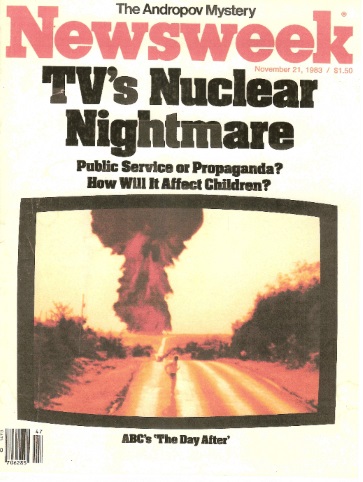

THE DAY AFTER (1983)
FULL FILM!
[A graphic, disturbing film about the effects of a devastating nuclear holocaust on small-town residents of eastern Kansas.] www.imdb.com...
[The Day After is an American television film that first aired on November 20, 1983, on the ABC television network. More than 100 million people watched the program during its initial broadcast. It is currently the highest-rated television film in history.
The film postulates a fictional war between NATO forces and the Warsaw Pact that rapidly escalates into a full-scale nuclear exchange between the United States and the Soviet Union. However, the action itself focuses on the residents of Lawrence, Kansas and Kansas City, Missouri, as well as several family farms situated near nuclear missile silos.
...President Ronald Reagan watched the film several days before its screening, on November 5, 1983. He wrote in his diary that the film was "very effective and left me greatly depressed," and that it changed his mind on the prevailing policy on a "nuclear war". The film was also screened for the Joint Chiefs of Staff. A government advisor who attended the screening, a friend of Meyer's, told him "If you wanted to draw blood, you did it. Those guys sat there like they were turned to stone." Four years later, the Intermediate-Range Nuclear Forces Treaty was signed and in Reagan's memoirs he drew a direct line from the film to the signing.] en.wikipedia.org...

edit on 30-12-2016 by IgnoranceIsntBlisss because: (no reason given)

WARGAMES (1983)
[A young man finds a back door into a military central computer in which reality is confused with game-playing, possibly starting World War III.] www.imdb.com...
[WarGames is a 1983 American Cold War science-fiction film written by Lawrence Lasker and Walter F. Parkes and directed by John Badham. The film stars Matthew Broderick, Dabney Coleman, John Wood, and Ally Sheedy.
The film follows David Lightman (Broderick), a young hacker who unwittingly accesses WOPR (War Operation Plan Response), a United States military supercomputer originally programmed to predict possible outcomes of nuclear war. Lightman gets WOPR to run a nuclear war simulation, originally believing it to be a computer game. The computer, now tied into the nuclear weapons control system and unable to tell the difference between simulation and reality, attempts to start World War III.] en.wikipedia.org...
And the sequel:
WARGAMES: THE DEAD CODE (2008)
[The United State's Department of Homeland Security is led to believe an American teen hacker playing a terrorist-attack simulator game online is a real terrorist out to destroy the U.S. ] www.imdb.com...
WARGAMES: THE DEAD CODE (2008)
[The United State's Department of Homeland Security is led to believe an American teen hacker playing a terrorist-attack simulator game online is a real terrorist out to destroy the U.S. ] www.imdb.com...
edit on 30-12-2016 by IgnoranceIsntBlisss because: (no reason
given)
And for a piece of DOD propaganda history. I guess it would be 'non-fiction-fiction'! Note that at a cinema as depicted in Matinee (1993)
pieces like this would likely come on between the trailers and the feature presentations....

There's hardly a better historical example of an over the top piece of doom monger porn than The House In The Middle (1954), or as I like to call it "CLEAN UP AND PAINT YOUR HOUSE OR DIE (1954)". This piece was produced by the "National Clean Up - Paint Up - Fix Up Bureau", and centered around little sheds up against atomic bombs out at the Nevada Test Range. In hindsight, it plays out like slapstick humor as if you pause the shots you can tell the houses not in the middle were designed to ignite into fiery infernos. My favorite scene is where they have big piles of crumpled newspapers all poofed out pinned down with chicken wire up against a dry rotted wood fence. This film short is so remarkable that at least once a year, for a decade now, I pull it up and sit in awe in its absurdity.

There's hardly a better historical example of an over the top piece of doom monger porn than The House In The Middle (1954), or as I like to call it "CLEAN UP AND PAINT YOUR HOUSE OR DIE (1954)". This piece was produced by the "National Clean Up - Paint Up - Fix Up Bureau", and centered around little sheds up against atomic bombs out at the Nevada Test Range. In hindsight, it plays out like slapstick humor as if you pause the shots you can tell the houses not in the middle were designed to ignite into fiery infernos. My favorite scene is where they have big piles of crumpled newspapers all poofed out pinned down with chicken wire up against a dry rotted wood fence. This film short is so remarkable that at least once a year, for a decade now, I pull it up and sit in awe in its absurdity.
I had meant to cover this after my Final Fantasy post above:
I guess it was in 2014 that I finally took proper note of how some of these games now, when properly edited contain proper films within them. I've been well familiar with how games have long been marching as interactive 'movies', but it wasn't until I noted South Park: Stick of Truth (2014) did I set about checking out in YouTube some of the other 'movies' that are to be found. With Stick of Truth the game itself seamlessly plays out in even better visual quality than the show. But just the cutscene edit versions will suffice the viewer, where to have seen the entire South Park canon it is a must (and their new one, South Park: The Fractured but Whole (2017).
What's neat about this scene is the 'movies' are all up in full versions on YouTube.
Since I've been out of being a gamer & working in the game industry both for some years, I'm not too hip on releases on this front, but a choice specimen from this scene I have played that happens to fit the list perfectly here is:
INJUSTICE: GODS AMONG US (2013)
Here's one without the in-game fight scenes: www.youtube.com...
[The storyline is set within an alternate version of the Justice League's universe. In this reality, Superman establishes a new world order after the Joker tricks him into killing Lois Lane and destroying Metropolis. In an effort to stop this, Batman summons counterparts of the League's members from another universe, including his own and Superman's, to join his insurgency and end the totalitarian regime.] en.wikipedia.org...:_Gods_Among_Us
I guess it was in 2014 that I finally took proper note of how some of these games now, when properly edited contain proper films within them. I've been well familiar with how games have long been marching as interactive 'movies', but it wasn't until I noted South Park: Stick of Truth (2014) did I set about checking out in YouTube some of the other 'movies' that are to be found. With Stick of Truth the game itself seamlessly plays out in even better visual quality than the show. But just the cutscene edit versions will suffice the viewer, where to have seen the entire South Park canon it is a must (and their new one, South Park: The Fractured but Whole (2017).
What's neat about this scene is the 'movies' are all up in full versions on YouTube.
Since I've been out of being a gamer & working in the game industry both for some years, I'm not too hip on releases on this front, but a choice specimen from this scene I have played that happens to fit the list perfectly here is:
INJUSTICE: GODS AMONG US (2013)
Here's one without the in-game fight scenes: www.youtube.com...
[The storyline is set within an alternate version of the Justice League's universe. In this reality, Superman establishes a new world order after the Joker tricks him into killing Lois Lane and destroying Metropolis. In an effort to stop this, Batman summons counterparts of the League's members from another universe, including his own and Superman's, to join his insurgency and end the totalitarian regime.] en.wikipedia.org...:_Gods_Among_Us
edit on 30-12-2016 by IgnoranceIsntBlisss because: (no reason given)
Before leaving the game-movies topic, I'd like to inject a killer D+A+PA short made by my Transalchemy friends that masterfully stitches scenes from
several games (and much much more) together:
ELE (2010)
ELE (2010)
edit on 30-12-2016 by IgnoranceIsntBlisss because: (no reason given)
Now this is interesting...
This fascinating essay goes on to cover many architectural motifs, including:

Architectural Dystopian projections in the films Metropolis, Brazil and The Island
In the proposals which describe utopian constructions envisioned by philosophers, utopian socialists and writers alike, the uniformity of the needs, assertions and believes of each utopia’s members is considered as a given. Uniformity takes away personal expression, multiplicity and difference, essential elements of life as well as of creative expression, granting priority to the interests of the majority in the name of equality and justice. The determinism of this assertion as well as its inevitable bankruptcy has served as a starting point for the majority of dystopian films. Fiction films, such as Metropolis, Brazil and The Island, are commented below in relation to the architectural environments represented in them, the ideological basis of their choices and the timeliness of the dystopian visions which they put forward. According to Maria Luise Bernieri: “Utopians tend to forget that society is a living organism and that its organization must be an expression of life and not just a dead structure”. The paternalistic monomania of utopian visions becomes a leitmotiv in fiction films describing dystopia, which demand that their members show flexibility and adaptability to an established social structure and a political organization.
A starting point for the following filmic dystopias is the belief that material and technological innovations will abolish everyday life as we know it and upgrade all aspects of living. For the end of the nineteenth century this belief was symbolised by the faith in the machine, in the late twentieth century this was replaced by the faith in digital technology and later in biotechnology.
This fascinating essay goes on to cover many architectural motifs, including:
In Brazil, the mechanized everyday fails to deliver what it has promised: comfort, convenience and time saving. Domestic gadgets malfunction, bureaucracy commits mistakes and networks create a chaotic public and private space. Networks of water, heating and communications shape an intricate patchwork, taken out of the post-apocalyptic Walking City (1964) of Archigram. The stage design and commentary of the film though is closer to pop futuristic illustrations of this English architectural group of the sixties. The scenography of the film consists of an eclectic sample of the thirties and forties, while posters of the Ministry of Information copy propaganda posters of World War II. The Ministry of Information in Brazil, designed with Art Deco elements consistent with the overall retro atmosphere of the film,clearly references the iconography and architecture of fascism in Eu-rope, in the footsteps of the pioneering Metropolis (see for example “Tempelhof Airport” in Berlin, 1935-39). The monitoring, the recording of personal data and a set of laws and rules for even the smallest detail of everyday life, make up an authoritarian controlling state. The optimistic fantasy of a total and rationalistic organisation of life in Brazil collapses because of what it did not leave place for: randomness, difference and the personal.

edit on 30-12-2016 by IgnoranceIsntBlisss because: (no reason given)
The contents of the above article prompts me to post several chains of film spots. First...
While Metropolis (1927) is a proper sci-fi film of the 'Pure Dystopian' variety, artistically speaking it's a surrealist German Expressionism work.
Fans of the art stylization in Metropolis will surely want to check out other Expressionist classics such as M (1931) [which is sort of the sequel to Metropolis], as well as The Cabinet of Dr. Caligari (1920) and Nosferatu (1922).
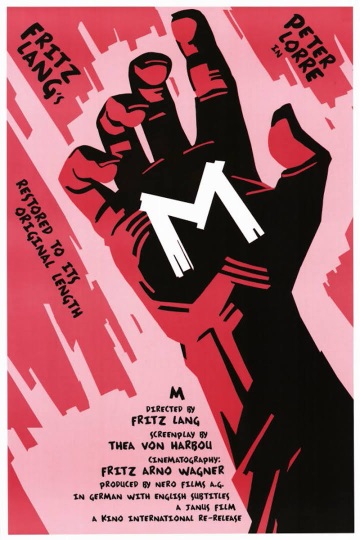


Modern Expressionism too exists, especially in paint, but also in film. Begotten (1991) [a proper surrealist film of the quite unsettling variety] would be such an example, as well as Pi (1998) [which is on the List]. Also here would be many of the works of Marylin Manson, Robb Zombie's House of 1000 Corpses (2003), and last but not least pretty much everything by Tim Burton. In a sense Burton's works almost belong on the List artistically speaking alone, while proper for the List when counting systematic crime dystopia's are his original contributions to the Batman film franchise (which as much as I prefer Nolan's Batman reboot, the Expressionist touch that Gotham mandates was mostly a no show). In closing, fans of the artistic style of the Batman animated series & films of more modern times are unwitting fans of German Expressionism of old.
While Metropolis (1927) is a proper sci-fi film of the 'Pure Dystopian' variety, artistically speaking it's a surrealist German Expressionism work.
Welcome to the first article in Art House, a series detailing the evolution of art house films, and their impact on the relationship between art and cinema. The term art house refers to films that are artistic or experimental in nature, and are generally not part of the commercial mainstream. It is interesting to note that unlike many other forms of avant-garde, filmic avant-garde does not typically generate the profits earned by its musical, visual, and literary counterparts. Most artists who have produced avant-garde films have had to rely on other artistic media as a source of income, including Andy Warhol (American, 1928–1987).1 However, there are several films that have crossed over into the realm of mainstream cinema, and have been both financially successful as well as stylistically influential. This article focuses on German Expressionism, one of the earliest artistic genres to influence filmmaking, and one that arguably paved the way for many other avant-garde styles and techniques.
German Expressionism is an artistic genre that originated in Europe in the 1920s, and is broadly defined as the rejection of Western conventions, and the depiction of reality that is widely distorted for emotional effect. Heavily influenced by artists such as Vincent van Gogh, Edvard Munch, and El Greco, Expressionists were less concerned with producing aesthetically pleasing compositions as they were with creating powerful reactions to their work through the use of bright, clashing colors, flat shapes, and jagged brushstrokes. In its nature, the movement was interested in the relationship between art and society, and encompassed a broad range of fields, including architecture, painting, and film. Expressionist films were initially born out of Germany’s relative isolation during the 1910s, and quickly generated high demand due to the government’s ban on foreign films. The films’ appeal soon spread to an international audience, and by the early 1920s, many European filmmakers had begun experimenting with the absurd and wild aesthetics of German cinema. Two of the most influential films of the era were Metropolis (1927), by Fritz Lang (Austrian, 1877–1961), and The Cabinet of Dr. Caligari (1920), by Robert Wiene (German, 1873–1938). Similar to Expressionist paintings, Expressionist films sought to convey the inner, subjective experience of its subjects. news.artnet.com...
Fans of the art stylization in Metropolis will surely want to check out other Expressionist classics such as M (1931) [which is sort of the sequel to Metropolis], as well as The Cabinet of Dr. Caligari (1920) and Nosferatu (1922).



Modern Expressionism too exists, especially in paint, but also in film. Begotten (1991) [a proper surrealist film of the quite unsettling variety] would be such an example, as well as Pi (1998) [which is on the List]. Also here would be many of the works of Marylin Manson, Robb Zombie's House of 1000 Corpses (2003), and last but not least pretty much everything by Tim Burton. In a sense Burton's works almost belong on the List artistically speaking alone, while proper for the List when counting systematic crime dystopia's are his original contributions to the Batman film franchise (which as much as I prefer Nolan's Batman reboot, the Expressionist touch that Gotham mandates was mostly a no show). In closing, fans of the artistic style of the Batman animated series & films of more modern times are unwitting fans of German Expressionism of old.
edit on 30-12-2016 by IgnoranceIsntBlisss because: (no reason given)

Now before unleashing a barrage of film spot postings, and straying away from the architecture topic article that prompted them, it's mandatory I plug Subtopia by architect Bryan Finoki. I originally found his realm due to him doing a review of my DARPA iXo AI Control Grid: The Official Version (2007) film. After checking out his site I was an instant fan. Sadly he hasn't been making proper posts there since 2013, but he is active on Twitter I'm now noticing.
Here are some random visual elements from Subtopia:







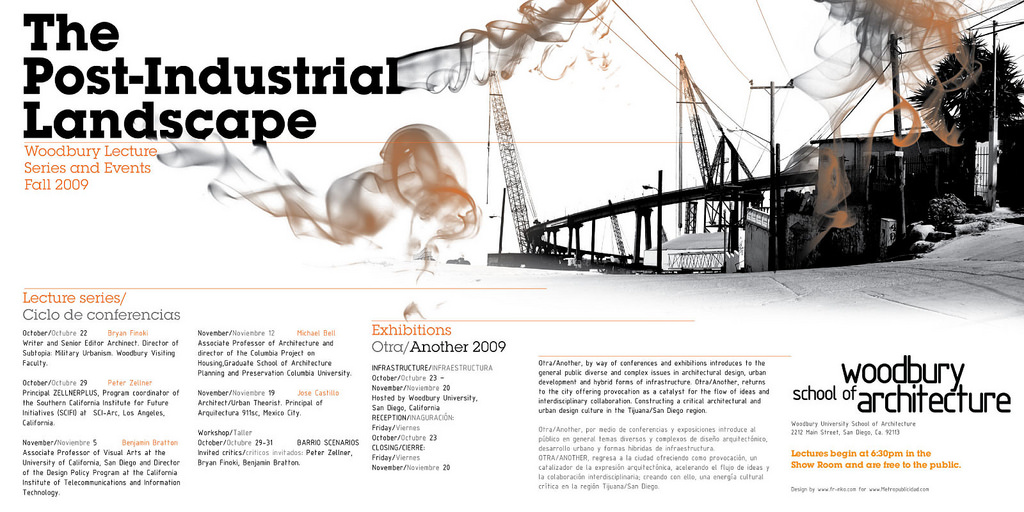
edit on 30-12-2016 by IgnoranceIsntBlisss because: (no reason given)
And Subtopia's piece on my DARPA iXo piece:
DARPA IXO A.I. CONTROL GRID: THE OFFICIAL VERSION (2007)
Note: I've set a mandate herein that non-fiction not apply (otherwise this would be diluted with endless non-fiction documentaries), yet with this of all my films although this is 'real world project stuff', much of all of that "blue sky" scene yet remains "sci-fi" (although not all if it), and that's why this piece but not many of my others made my opening List.
The DARPA Trip
We pause from our normal programming (or, maybe not) for a moment to take a brief – albeit hallucinatory – intermission. If the ‘robo-snipers’ and ‘automated kill zones’ didn’t freak you out then perhaps this will. Check out this video – DARPA’s iXo Artificial Intelligence Control Grid: 20 cyber-bugged minutes virtually adrift inside the surreal cytoplasmic warfare-obsessed cerebral distortions of DARPA’s techno-militaristic planning regime. If the war machine could dream this would surely be it. Seriously, this is some freaky-ass #.
The dudes over at Ignorance Isn’t Bliss put this together. In their own words:
This was constructed almost entirely using government / military quotes, animations, videos, images and photos. The narrative is sourced from government quotes from start to finish. It is the “official version”, if you will, but in an unprecedented format.
It unveils the governments numerous and ongoing programs related to A.I., “NBIC”, the “Global Information Grid”, nanotechnology, biotechnology, autonomous drones, “naval sea-bases”, space weapons, weather modification… or more directly: domestic and global totalitarian technological domination. American Imperialism meets Artificial Intelligence.
Needless to say, it plays like some narco-induced Rumsfeldian mash-up of war-play gameification, complete global surveillance mechanization, programmed battlespaces and landscape lobotomization, all timed to the frenetic and pummeling gait of a sci-fi drum ‘n bass soundtrack that is absolutely perfect in a swarming entomomechanophilic army kind of way.
I want to project the whole video onto a chunky battered bunker wall in some undisclosed location for a future subtopian meeting of the minds, so to speak, or, well, some other vaguely viable reason. Though, I wonder if the good ol' boys at DARPA have seen this and whether they actually like it or not. You never know about the unintended consequences. Maybe they will use it as a "hip commercial" of some kind. Either way, turn up your speakers, sit back and trip over the psycho-urban assault.
DARPA IXO A.I. CONTROL GRID: THE OFFICIAL VERSION (2007)
Note: I've set a mandate herein that non-fiction not apply (otherwise this would be diluted with endless non-fiction documentaries), yet with this of all my films although this is 'real world project stuff', much of all of that "blue sky" scene yet remains "sci-fi" (although not all if it), and that's why this piece but not many of my others made my opening List.
edit on 30-12-2016 by IgnoranceIsntBlisss because: (no reason
given)
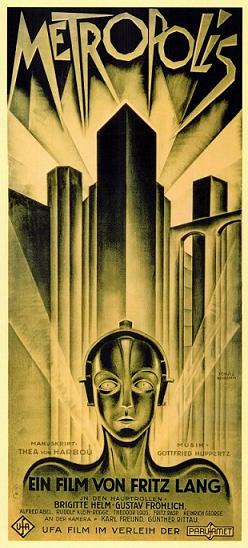
METROPOLIS (1927)
[In a futuristic city sharply divided between the working class and the city planners, the son of the city's mastermind falls in love with a working class prophet who predicts the coming of a savior to mediate their differences.] www.imdb.com...
[Metropolis is a 1927 German expressionist epic science-fiction drama film directed by Fritz Lang. He and his wife, Thea von Harbou, wrote the silent film, which starred Gustav Fröhlich, Brigitte Helm, Alfred Abel and Rudolf Klein-Rogge. Erich Pommer produced it in the Babelsberg Studios for Universum Film A.G.. It is regarded as a pioneering work of the science-fiction genre in movies, being among the first feature-length movies of the genre.] en.wikipedia.org...(1927_film)

Dystopian Art Meets Rube Goldberg
The next few films as prompted from the architecture piece above either directly involve or to me speak of inspiration of what is known as the Rube GoldBerg Machine. As a 'natural born inventor', as long as I can remember these sorts of contraptions and art have always been things that warm my heart, although in the 80's as a child I never knew what they 'really were'.
A Rube Goldberg machine is a contraption, invention, device, or apparatus that is deliberately over-engineered to perform a simple task in a complicated fashion, generally including a chain reaction. The expression is named after American cartoonist and inventor Rube Goldberg (1883–1970).
Over the years, the expression has expanded to mean any confusing or complicated system. For example, news headlines include "Is Rep. Bill Thomas the Rube Goldberg of Legislative Reform?" and "Retirement 'insurance' as a Rube Goldberg machine". en.wikipedia.org...
Notable examples from yesteryear include many examples from Looney Tunes (at the Foghorn Leghorn farm of particular note), the boardgame Mousetrap, numerous elements such as the gate Chunk had to do the "truffle Shuffle" for Mouth to activate in The Goonies (1985), and Pee Wee's house in Pee Wee’s Big Adventure (1985).
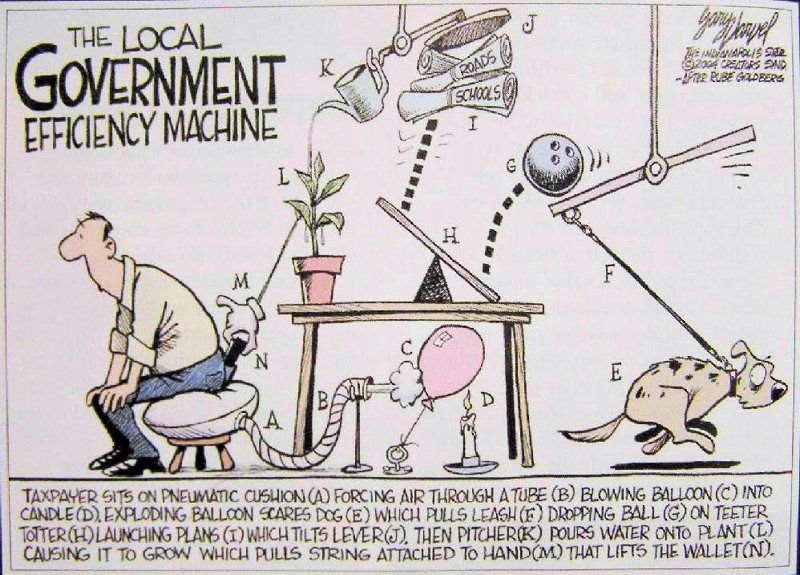
The next chain of dystopian film pieces feature cinematic art direction styles in not outright engineering designs which draw inspiration from and pay homage to Rube Goldberg principles, which from what I know about real world dystopia's such as the one we live in, overly-complicated structures of power are the systemic foundations of government in societies which are supposedly "democracies".
The dystopian films of relavence here are Brazil (1985), Delicatessen (1991), The City of Lost Children (1995),and The Zero Theorem (2013). Also worthy of note here is Mousehunt (1997), which the entire duration of the film fits the mold of this entry both artistically & mechanically. In terms of the List here, artistically speaking definitely belongs on the List, although I couldn't decide whether or not it belonged on the List beyond that so it didn't make the cut.
edit on 30-12-2016 by IgnoranceIsntBlisss because: (no reason given)
BRAZIL (1985)
[A bureaucrat in a retro-future world tries to correct an administrative error and himself becomes an enemy of the state.] www.imdb.com...
[Brazil is a 1985 dystopian science fiction film[10] directed by Terry Gilliam and written by Gilliam, Charles McKeown, and Tom Stoppard. The film stars Jonathan Pryce and features Robert De Niro, Kim Greist, Michael Palin, Katherine Helmond, Bob Hoskins and Ian Holm.
The film centres on Sam Lowry, a man trying to find a woman who appears in his dreams while he is working in a mind-numbing job and living in a small apartment, set in a consumer-driven dystopian world in which there is an over-reliance on poorly maintained (and rather whimsical) machines. Brazil's bureaucratic, totalitarian government is reminiscent of the government depicted in George Orwell's Nineteen Eighty-Four, except that it has a buffoonish, slapstick quality and lacks a Big Brother figure.] en.wikipedia.org...(1985_film)
[A bureaucrat in a retro-future world tries to correct an administrative error and himself becomes an enemy of the state.] www.imdb.com...
[Brazil is a 1985 dystopian science fiction film[10] directed by Terry Gilliam and written by Gilliam, Charles McKeown, and Tom Stoppard. The film stars Jonathan Pryce and features Robert De Niro, Kim Greist, Michael Palin, Katherine Helmond, Bob Hoskins and Ian Holm.
The film centres on Sam Lowry, a man trying to find a woman who appears in his dreams while he is working in a mind-numbing job and living in a small apartment, set in a consumer-driven dystopian world in which there is an over-reliance on poorly maintained (and rather whimsical) machines. Brazil's bureaucratic, totalitarian government is reminiscent of the government depicted in George Orwell's Nineteen Eighty-Four, except that it has a buffoonish, slapstick quality and lacks a Big Brother figure.] en.wikipedia.org...(1985_film)
DELICATESSEN (1991)
[Post-apocalyptic surrealist black comedy about the landlord of an apartment building who occasionally prepares a delicacy for his odd tenants.] www.imdb.com...
[Delicatessen is a French 1991 post-apocalyptic black comedy film directed by Jean-Pierre Jeunet and Marc Caro, starring Dominique Pinon and Karin Viard. It was released in North America as "presented by Terry Gilliam." Like its successor, The City of Lost Children (1995), it was an homage to the works of Gilliam.] en.wikipedia.org...(film)
[Post-apocalyptic surrealist black comedy about the landlord of an apartment building who occasionally prepares a delicacy for his odd tenants.] www.imdb.com...
[Delicatessen is a French 1991 post-apocalyptic black comedy film directed by Jean-Pierre Jeunet and Marc Caro, starring Dominique Pinon and Karin Viard. It was released in North America as "presented by Terry Gilliam." Like its successor, The City of Lost Children (1995), it was an homage to the works of Gilliam.] en.wikipedia.org...(film)
new topics
-
Holy Cow! Erm...Six Legged Turkey!!
World Sports: 3 hours ago -
Ben Habib has Left Reform UK
Regional Politics: 7 hours ago -
Turkey Day Rhyme…
Short Stories: 7 hours ago -
Can someone please translate Biden's speech?
US Political Madness: 7 hours ago -
NIH Chief Confesses COVID Initiatives Were "Completely Made Up " OMG Investigates
Health & Wellness: 8 hours ago -
Awesome Dip Recipe
Food and Cooking: 11 hours ago -
Vladimir Putin's speech at the meeting of the CSTO Collective Security Council
World War Three: 11 hours ago
top topics
-
NIH Chief Confesses COVID Initiatives Were "Completely Made Up " OMG Investigates
Health & Wellness: 8 hours ago, 9 flags -
Vladimir Putin's speech at the meeting of the CSTO Collective Security Council
World War Three: 11 hours ago, 8 flags -
Traveling the world with no passport
Social Issues and Civil Unrest: 16 hours ago, 7 flags -
Can someone please translate Biden's speech?
US Political Madness: 7 hours ago, 7 flags -
Awesome Dip Recipe
Food and Cooking: 11 hours ago, 5 flags -
Turkey Day Rhyme…
Short Stories: 7 hours ago, 5 flags -
Ben Habib has Left Reform UK
Regional Politics: 7 hours ago, 4 flags -
Holy Cow! Erm...Six Legged Turkey!!
World Sports: 3 hours ago, 2 flags
active topics
-
V.P. Kamala Harris releases a video and nobody understands why
US Political Madness • 89 • : chr0naut -
Vladimir Putin's speech at the meeting of the CSTO Collective Security Council
World War Three • 60 • : Astrocometus -
The Party of Peace - Trump Cabinet Picks Targeted with Death Threats
US Political Madness • 41 • : NorthOS -
-@TH3WH17ERABB17- -Q- ---TIME TO SHOW THE WORLD--- -Part- --44--
Dissecting Disinformation • 3393 • : RelSciHistItSufi -
Traveling the world with no passport
Social Issues and Civil Unrest • 9 • : KnowItAllKnowNothin -
NIH Chief Confesses COVID Initiatives Were "Completely Made Up " OMG Investigates
Health & Wellness • 14 • : KnowItAllKnowNothin -
Holy Cow! Erm...Six Legged Turkey!!
World Sports • 2 • : RazorV66 -
Awesome Dip Recipe
Food and Cooking • 5 • : JJproductions -
Turkey Day Rhyme…
Short Stories • 4 • : JJproductions -
Mood Music Part VI
Music • 3721 • : BrucellaOrchitis
